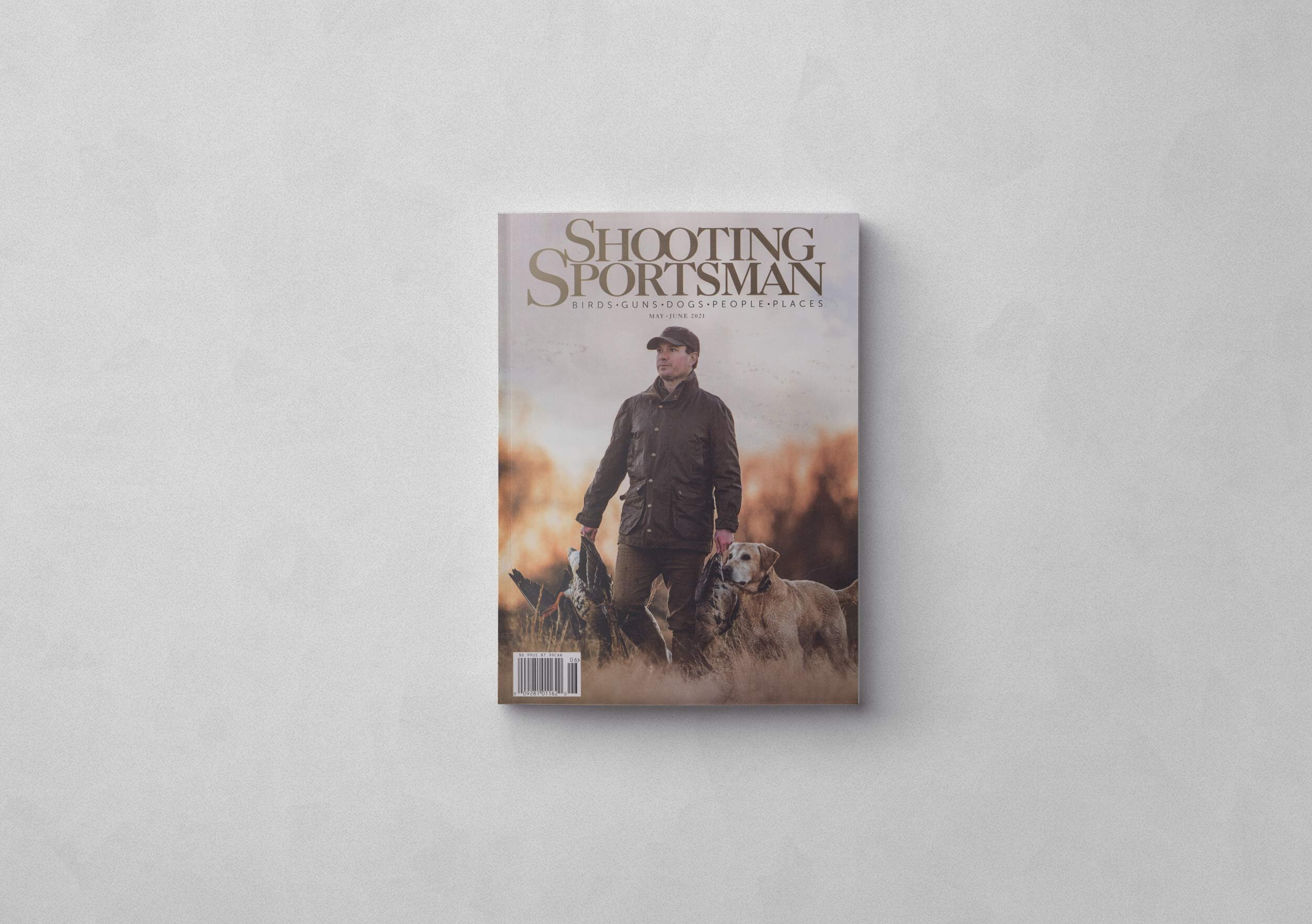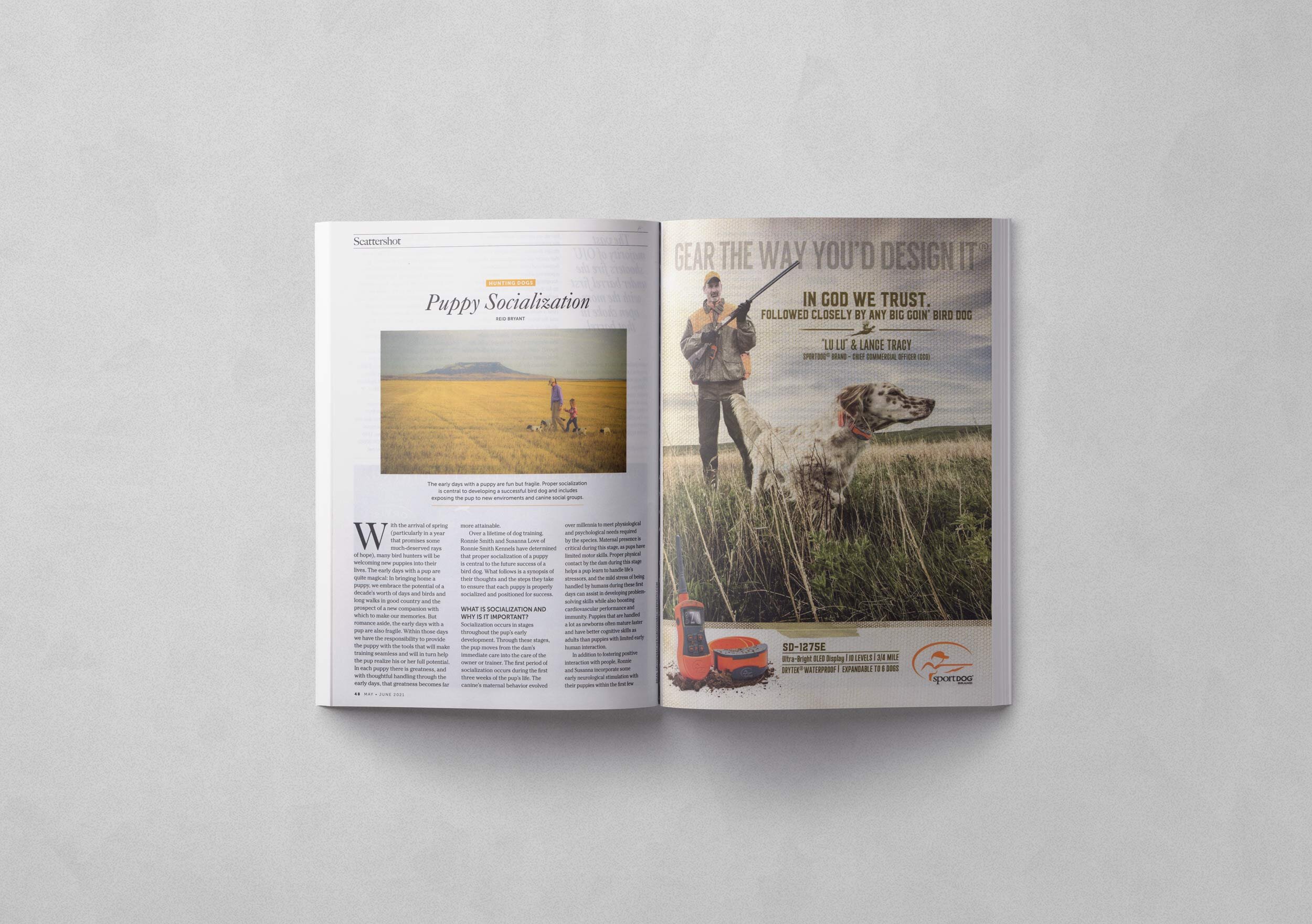Puppy Socialization
With the arrival of spring (particularly in a year that promises some much-deserved rays of hope) many bird hunters will be welcoming new puppies into their lives. The early days with a pup are quite magical: in bringing home a puppy we embrace the potential of a decade’s worth of days and birds and long walks in good country, and the prospect of a new companion with which to make our memories. But romance aside, the early days with a new pup are also fragile. Within those days we have the responsibility to provide a puppy with the tools that will make training seamless and will in turn help the pup realize his/her full potential. In each puppy there is greatness, and with thoughtful handling through the early days, that greatness becomes far more attainable.
The following, adapted from Training Bird Dogs with Ronnie Smith Kennels – Proven Techniques and an Upland Tradition, provides some essential considerations regarding puppyhood. Over a lifetime of dog training, Ronnie Smith and Susanna Love have determined that proper socialization of a puppy is central to the future success of the bird dog. What follows is a synopsis of their thoughts, and the steps that they take to ensure each puppy is properly socialized and positioned for success.
What Is Socialization and Why Is It Important?
Socialization occurs in stages throughout the pup’s early development. Through these stages, the pup moves from the dam’s immediate care into the care of the owner or trainer. The first period of socialization occurs during the first three weeks of a pup’s life. The canine’s maternal behavior evolved over millennia to meet physiological and psychological needs required by the species. Maternal presence is critical during this stage, as the pups have limited motor skills. Proper physical contact by the dam during this stage helps a pup learn to handle life’s stressors, and the mild stress of being handled by humans during these first days can assist developing problem-solving skills while also boosting cardiovascular performance and immunity. Puppies that are handled a lot as newborns often mature faster and have better cognitive skills as adults than puppies with limited early human interaction.
In addition to positive interaction with people, we incorporate some early neurological stimulation with our puppies within their first few weeks. Research has shown that the introduction of minor stressors enhances neurological development, development of the immune system, the ability to adapt to new environments, and stress tolerance. Our practice of early physical and neurological stimulation is based on the US military’s research and program called the “Super Dog Program.” In training dogs for critical military and police applications, researchers found that minor stresses on a puppy during the age of 3 to 16 days allowed puppies to deal with new or challenging situations more effectively as an adult. In layman’s terms, puppies that undergo a Super Dog Program have better “bounce-back” when dealing with the stress of training.
The Super Dog Program takes a puppy through five exercises every day from day three through day 16. Tactile stimulation occurs when the puppy is held and the sensitive area between his toes is gently tickled with a Q-tip for three to five seconds. Physical manipulation occurs in the second and third exercises when the pup is held sitting upright for three to five seconds, then held securely upside-down with his head pointed directly downward for three to five seconds, then held supine on its back for three to five seconds. And last, the pup experiences thermal stimulation by being placed on a cool washcloth for three to five seconds. This sequence can be done with a healthy pup no more than once a day and only for the short period recommended. Of course, common sense should be exercised if unusual situations occur.
We believe this simple process followed by proper socialization helps prepare dogs for various facets and stressors of life, from living in an urban environment to performing on hunts in a range of unfamiliar locations.
The second stage of development in socialization occurs from about four to 16 weeks. From a socialization standpoint, this period is critical as it is often during this time that the pup moves away from its littermates into the owner’s home. During this stage, puppies begin to explore their environment, and to establish and test a set of social skills through interactions with the dam and littermates. During this stage, the dam makes an immense impact on how the pup views and reacts to the world. For example, a dam that is sound-sensitive may startle at any loud noise and run back into the whelping box. In this case, puppies will instinctively cue off the response of their dam and learn that loud noises are cause for alarm. Puppies growing up with a sound-sensitive mother will likely be sound-sensitive as adults. This is one reason that we use whelping pens that have a slam door. At a young age, our puppies learn to associate a loud noise with mama coming in or going out. Our puppies make a positive association with loud noises from day one.
Dogs are pack animals. There are social norms associated with a pack mentality that people cannot teach dogs. Dogs absolutely have to be around other dogs during this second stage of socialization in order to socialize effectively. There are a few things that you can do to help your dog “be a dog” and to facilitate healthy early socialization. First, it is important that you allow a pup to stay with his litter until at least eight weeks of age, provided that the litter represents a safe and healthy environment (exceptions include scenarios in which puppies are being raised by a fearful dam or even an aggressive one). Next, it is key that when the pup comes into your home, you allow him to play with other dogs. Keep an eye on these interactions and make sure they are positive; if an older dog is aggressive toward a puppy, he can cause long-term physical or psychological damage to the pup. Finally, be certain that the pup has a dynamic early experience. Expose him to new environments and various canine social groups. Despite our busy lives, this period of socialization requires our time, energy, and effort—consider that time spent as an investment in the future that will pay dividends in the aptitude and attitude of the bird dog in your life.
The final stage of socialization essentially follows the dog through its life and enables these early lessons to be cemented. This stage requires that we maintain the learned behaviors and enhance the dog’s flexibility and positive response to stressors and stimuli. For practical purposes, this just means that you must keep your dog engaged. Give him new experiences and keep his schedule dynamic. Travel with him to hunt or trial, walk him on a lead through a busy downtown area, introduce him to puppies, older dogs, and a range of people. The greater his exposure through life, the more limber his mind will remain, and the more practiced he will be when encountering challenges in the field and in training.
Conclusion
When welcoming a new pup into the home, or when welcoming a new litter of pups into the kennel, it is vital to take the early opportunities for socialization seriously. The legendary Delmar Smith often spoke about trainers and interactions leaving “fingerprints” on a dog. Those fingerprints, and the context in which they are placed on a puppy, are the responsibility of the owner/trainer. They have lasting impact and must be considered.
See socialization as a process akin to tempering metal. It ensures toughness and allows the metal to be shaped and sharpened. In the case of a puppy, proper socialization enhances the agility of the mind, and the ability of the pup to move through the stressors of training. The resilient temperament and durable mindset that come from effective socialization set a puppy up to learn, and only through education can a pup realize his true potential.
First Published in Shooting Sportsman Magazine


